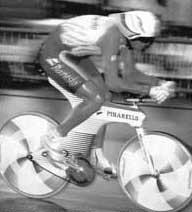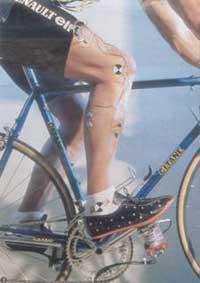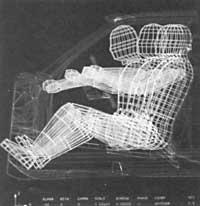Wheel
1996/10/01 Irureta Azkune, Onintza Iturria: Elhuyar aldizkaria
“I will give a containment point and move the land,” Archimedes said. For Archimedes, with very little force, it was theoretically possible to carry out works that required great energies. And all this thanks to the so-called simple machines; the wheel is only one of its applications.
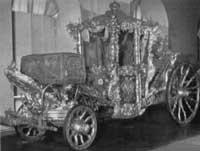
What we see spinning is a simple instrument, but it has certainly been one of the most important inventions for the human being.
However, it is sometimes questioned what was the first use of the wheel. Many believe that the origin of the wheel is to put a lot of logs on the ground and carry over a slip load. However, the idea that the wheel comes along that way is not correct. Archaeologists have confirmed that the first such trial was the potter's lathe. Therefore, the first potter and then the man used the wheel for transport.
Transport was a breakthrough thanks to the wheel. The transport of goods from one village to another was easier and entire villages migrated to cities where they had primary food and supplies.
History of the Wheel
The first wheels of history, both used by the potter and the transport wheel, both of wood, have not reached our hands any trace, since they have been corrupted. However, it can be ensured that they knew wooden lathes, since it is evident that the clay containers that have been found were manufactured in this wheel. In Mesopotamia were found the first clay objects manufactured around, approximately a. C. 3,500 years. 250 years later, in a clay tablet appears the cart drawn with wheels. Until then, boats were found around and drawn wheel, but the most reliable test of the wheel in Mesopotamia, a. C. It was found between 3,000 and 2,000 years: remains of the first wheel. The wheel was made up of wooden plates and is believed to revolve around an axis.
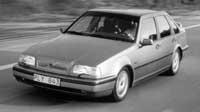
The wheel spread rapidly from its origin to the Middle East, but during this time the wheel was not known in Southeast Asia, Sub-Saharan Africa, Australia and Polynesia. In America the wheel was invented, but it was not used as a tool. Archaeologists found ceramic works in Mexico, for example, animals appear playing on wheels. It seems, then, that they used the wheels as a toy and not as a tool. Knowledge of the wheel has always been classified by civilization and society that did not know the wheel has despised. However, pre-Columbian American culture reached a high artistic and technical development, although it did not know the wheel.
Following the chronology of the wheel, the next novelty a. C. It came to us in 2000 years, when wood was discarded and metal wheels were used.
The wheels, increasingly resistant and fast, gave great importance to material and appearance. Radios so well known to us to. C. They were invented in Mesopotamia in 2000 years. The functions of the wheels increased considerably, since the wheels with radius were much lighter. 500 years later the Egyptians used a four-spoke wheel in the war cars. Eight radios arrived from the Romans a thousand years later. It was not a mere increase of radios: just as in today's bikes, the radios were placed crossed. This wheel design was the antecedent of the wheel used in current means of transport.
Apart from these changes, for many centuries there were no major innovations. The breakthrough came in 1870 with the construction of a metal bicycle wheel.
Multifunction
We just said that the first circular piece that revolved on an axis was the potter's lathe. Subsequently new modes of transport of loads between wheels were created. First the wheels were placed on the cars. From the car and over time, bicycles, motorcycles, cars and train cars have used wheels of different types. The first wheels of the cars that took to the market were made of wood with the metal shaft. The next step was the iron wheel. XX. In the 1930s, steel plates were used for the wheels. Today, the alloy between magnesium and aluminum is mainly used in sports vehicles.
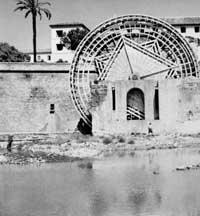
However, transports and potters have not been the only ones who have taken advantage of the discovery of the wheel. For example, the muzzle for spinning wool is ultimately a wheel. To grind grains of wheat or corn, at first slaves or animals were used, but soon man learned to take advantage of nature. First wind mills were built and then water mills or hydraulic wheels. The grain was grinding between wheels in the mills. Over time, in addition to grinding the hydraulic wheel, it was used to grind the fabric, operate the mechanical saws, etc.
To draw water from rivers and streams, a ferris wheel was used. They are also gallant wheels. In mechanical watches we also have gear wheels.
The wheel is simple, but it gives a lot of play. We can find it anywhere.
Wheel Physics
The wheel rotates and rotates, unless there is an opposite motion, always in the same direction and without varying the speed. Why?
To understand the physics of the wheel, three key words must be cited: precesion, inertia and centrifugal force.
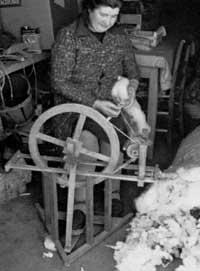
The precession is the movement of the axis of a rotating body due to an external force. If the spinning comb on the ground is pushed outward on the turning axis, the comb responds in the direction perpendicular to this force and the axis takes a movement around the original position, describing the reverse cone. In short, it can be said that the rotating body is resistant to not changing the position of its axis. This is also called a gyroscopic effect. In the case of the wheel also occurs and this resistance to the change of rotation plane allows to understand why the higher the speed by bicycle, the easier the balance is preserved. The immobilization of the bicycle is very difficult, since, in the absence of movement (and therefore of precesion), the system of struggle against external forces acting on the wheel does not have a spontaneous response.
Inertia is that a body cannot change its speed by itself. If the influence of an external force does not occur, the motionless body will not move or the moving body will always move at constant speed. On some occasion we all had to push to start the car. The first movement is not easy, but once it gets underway, at least it won't stop a bit, although we don't push it back. This is called inertia. Due to inertia, the object has resistance to speed change. All objects are associated with inertia and intensity depends on mass. The greater the mass, the greater the inertia.
In a system that rotates the centrifugal force is called force that pushes the mobile to move away from the turning center.
The object moving in the circle is changing at all times of direction. If the object is kept in circle, it will keep direction and speed constant. That is by inertia. Therefore, the object always exerts a force out of the center. This is called centrifugal force, i.e. force outward. Anything that moves in a circle makes that force out. For example, the piece of clay the potter has on the lathe makes force out. At higher turning speed of the object, greater centrifugal force presents.

Gai honi buruzko eduki gehiago
Elhuyarrek garatutako teknologia



